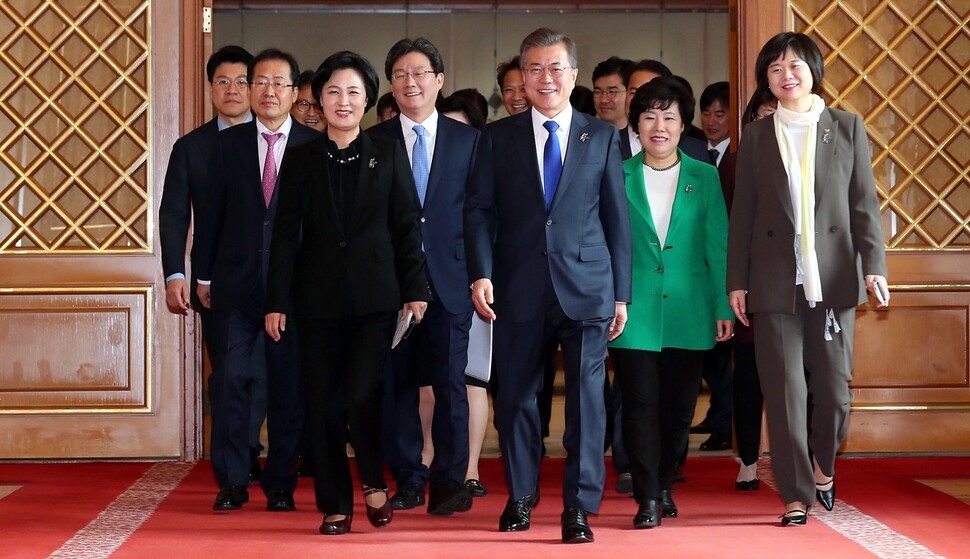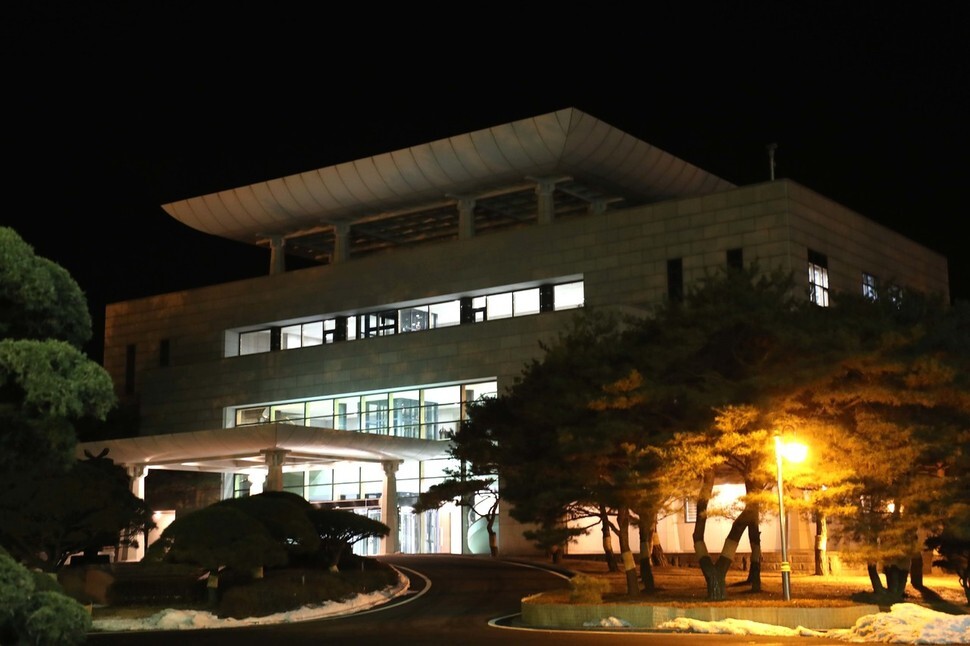hankyoreh
Links to other country sites 다른 나라 사이트 링크
President Moon discloses details of special delegation’s visit to North Korea

During a luncheon with the leaders of the five main ruling and opposition parties at the Blue House on Mar. 7, South Korean President Moon Jae-in gave a detailed explanation of how South and North Korea reached an agreement to hold a third inter-Korean summit at Panmunjeom at the end of April. The two sides had been holding closed-door meetings at Panmunjeom, and during a discussion about whether the summit should be held in Seoul, Pyongyang or Panmunjeom, North Korea chose Panmunjeom, Moon said.
During the meeting, Liberty Korea Party leader Hong Joon-pyo asked a number of questions about the inter-Korean summit, including when the meetings with the North had begun, where they had been held and who made the proposal. “There were no secret meetings outside the country,” Moon said in response. “As for who made the proposal, if you go back to the Berlin Declaration [last year], you could say that we made the proposal, and if you think of the New Year’s address [by North Korean leader Kim Jong-un on Jan. 1], you could say that the North Koreans responded favorably. It happened naturally.”
“[The meetings between South and North Korea] mostly took place in Panmunjeom. You also had the special envoy [Kim Yo-jong] and the high-ranking delegation from North Korea,” said Blue House National Security Advisor Chung Eui-yong, who was present at the luncheon.
Moon explained that it was North Korea that chose Panmunjeom as the location for the summit: “As for the location, we said that Pyongyang, Seoul and Panmunjeom would all be fine. Since Panmunjeom includes sections under the jurisdiction of South and North Korea, we said anywhere in Panmunjeom would be fine and that we could also spend one day in our half and the next day in their half… We made a number of proposals along those lines, and it was North Korea that opted to hold the summit at the House of Peace [on the South Korean side of the Joint Security Area].”
When Hong asked whether the summit had been scheduled for the end of April because of the local elections coming up on June 13, Moon said, “We expressed our viewpoint that, if the conditions permitted us to hold the summit at an early time, we wanted to create some distance from the local elections in June if at all possible. The upshot of a lot of back and forth between both sides was that the end of April was a good time. It doesn’t really make sense to insist on asking who was first and who wasn’t.”

Moon denies that local elections were a consideration in summit timing
“Not once did we think about the timing at the end of April in terms of domestic politics during our deliberations with North Korea. President Moon said during his presidential campaign that, if elected, he was willing to hold an inter-Korean summit during his first year in office, and North Korean special envoy Kim Yo-jong invited President Moon to visit Pyongyang as soon as possible when she met him on Feb. 10,” Chung explained.
“It’s extremely significant that the momentum for inter-Korean relations is being sustained instead of collapsing even during the South Korea-US joint military exercises [being held in April] and that North Korea has expressed its position that it will no longer make an issue of those exercises,” he added.
Bareun Mirae Party leader Yoo Seong-min asked whether there had been any side deals related to the agreement to hold a summit. “There were absolutely no side deals. North Korea may regard the start of dialogue as a reward in and of itself. The mere fact that inter-Korean dialogue has begun does not mean that sanctions and pressure will be relaxed or that any presents will be given,” Moon replied.
Even so, Moon attempted to lower expectations surrounding the the inter-Korean summit. “Because the summit must be held amid international sanctions against North Korea and because we have no choice but to abide by South Korea’s agreement with the US on the roadmap for denuclearization, it’s not possible to reach many [bilateral] agreements during the summit,” Yoo quoted Moon as saying.
In addition to Moon’s meeting with the party leaders, officials are starting to share more subjective impressions of Kim Jong-un, who met with the special delegation for more than four hours on Mar. 5. “When the special delegation first met Kim, they said they found him to be ‘frank and bold,’” a senior official at the Blue House told reporters on Mar. 7. The special delegation had no need to resort to any of the contingency plans it had prepared in case of difficulties during the discussion about the South Korea-US joint military exercises or the selection of the location of the summit, the official said.
By Kim Bo-hyeop, staff reporter
Please direct questions or comments to [english@hani.co.kr]
Editorial・opinion
![[Column] Season 2 of special prosecutor probe may be coming to Korea soon [Column] Season 2 of special prosecutor probe may be coming to Korea soon](https://flexible.img.hani.co.kr/flexible/normal/500/300/imgdb/original/2024/0426/3317141030699447.jpg) [Column] Season 2 of special prosecutor probe may be coming to Korea soon
[Column] Season 2 of special prosecutor probe may be coming to Korea soon![[Column] Park Geun-hye déjà vu in Yoon Suk-yeol [Column] Park Geun-hye déjà vu in Yoon Suk-yeol](https://flexible.img.hani.co.kr/flexible/normal/500/300/imgdb/original/2024/0424/651713945113788.jpg) [Column] Park Geun-hye déjà vu in Yoon Suk-yeol
[Column] Park Geun-hye déjà vu in Yoon Suk-yeol- [Editorial] New weight of N. Korea’s nuclear threats makes dialogue all the more urgent
- [Guest essay] The real reason Korea’s new right wants to dub Rhee a founding father
- [Column] ‘Choson’: Is it time we start referring to N. Korea in its own terms?
- [Editorial] Japan’s rewriting of history with Korea has gone too far
- [Column] The president’s questionable capacity for dialogue
- [Column] Are chaebol firms just pizza pies for families to divvy up as they please?
- [Column] Has Korea, too, crossed the Rubicon on China?
- [Correspondent’s column] In Japan’s alliance with US, echoes of its past alliances with UK
Most viewed articles
- 1[Column] Season 2 of special prosecutor probe may be coming to Korea soon
- 2‘We must say no’: Seoul defense chief on Korean, USFK involvement in hypothetical Taiwan crisis
- 3Is N. Korea threatening to test nukes in response to possible new US-led sanctions body?
- 4Division commander ordered troops to enter raging flood waters before Marine died, survivor says
- 5Amnesty notes ‘erosion’ of freedom of expression in Korea in annual human rights report
- 6Is Japan about to snatch control of Line messenger from Korea’s Naver?
- 7No good, very bad game for Korea puts it out of Olympics for first time since 1988
- 8[Editorial] Korea’s surprise Q1 growth requires objective assessment, not blind fanfare
- 9N. Korean delegation’s trip to Iran shows how Pyongyang is leveraging ties with Moscow
- 10Korea’s 1.3% growth in Q1 signals ‘textbook’ return to growth, says government